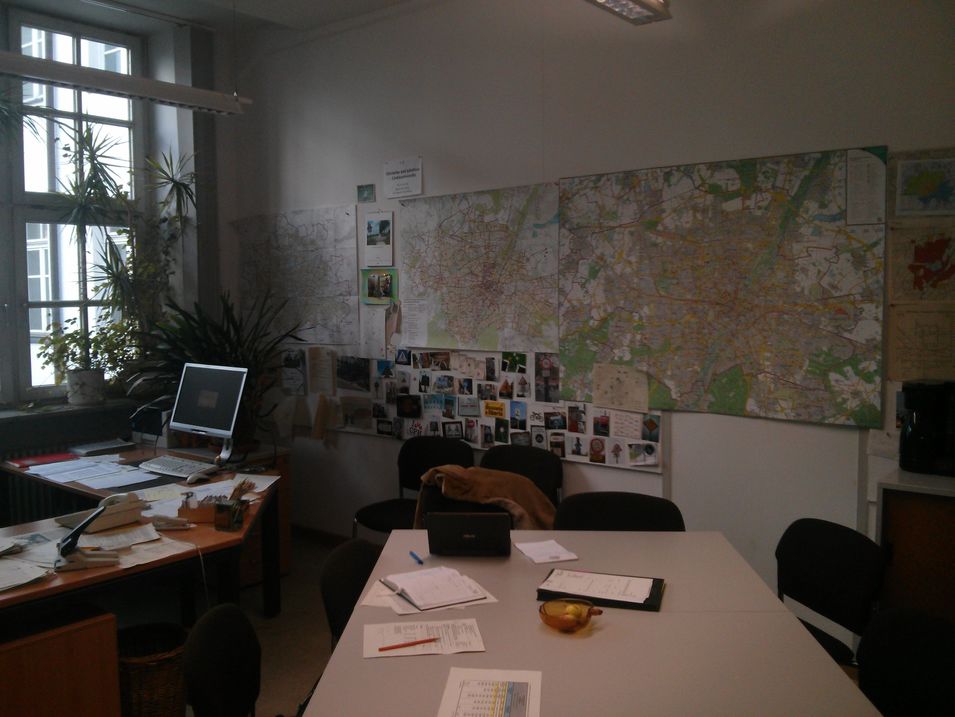How planners plan: knowledge, devices and imaginaries in planning cycling infrastructures

Context and question
Cycling is high on policy agendas throughout the world. Yet, making space for cyclists on urban roads is a far more contested issue than is often assumed, for three reasons. First, there are two competing planning approaches, one advocates that cyclist and motorized traffic should be separated as much as possible, the other that they should share the same space. Which rationale should inform the design of particular streets is often ambiguous and contested in concrete projects. Second, designing road infrastructure is not a simple ‘copy pasting’ of what has worked in other places and times. Third, potential impacts on other types of road users makes redesigning streets to the benefit of cyclists prone to critique, and contestation. The cycling lane that was recently built on the Gabelsbergerstrasse, right next to TUM’s central campus, sparked a small controversy as local politicians argued that the impact on motorized traffic was insufficiently taken into account.
Taking this into account, my PhD research project seeks to describe and analyze how planners plan and design urban road infrastructure, primarily based on theories developed within Science and Technology Studies (STS). I am particularly interested in two questions: First, how and to what degree planners make ‘decisions’ or, by contrast, implement general rules. The notion of decisions should here be understood in a Derridian sense, as involving a choice between at least two equally viable options. Second, how planners justify their actions in (relation to) moments of ‘crisis, disequilibrium, critique, dispute, orcontestation’ (Boltanski & Thévenot, 2006). These two concepts, decisions and justifications, are key for approaching the politics of everyday planning processes, and how agreement over plans and designs is reached.
Analytical approach
My research project can be situated in the socio-material constructivist tradition in STS. This perspective holds that the agency of any type of actor, including planners, is a relational achievement based on the co-functioning of human and non-human entities (Law, 1997). Planners, for example, work with models to make sense of the world and to make decisions. Planning operations can thus be understood as distributed over a human/non-human network. As a consequence, the research question of ‘how planners plan’ entails an inquiry into the hybrid collective sin which planners take part.
Socio-material constructivism also refrains from any a priori rigid analytical frameworks. Therefore, my analytical approach is organized along five dimensions of which, for the sake of brevity, the three most important ones are:
• KNOWLEDGE; I aim to understand how planners come to understand the world around them, that is how knowledge is produced and/or encountered and, especially, how incommensurability between different ways of knowing are dealt with.
• DEVICES: I aim to focus on the various devices deployed in planning practice (such as models, maps, theories, papers, policy documents, regulations, and PowerPoints) and how they shape the processes involved. Computer models seem particularly interesting here as they have been argued to create points of contact between different ways of knowing (Harvey,2009), but especially transportation models are often experienced as highly opaque (Brömmelstroet & Bertolini, 2011).
• IMAGINARIES: I aim to study the shaping capacity of future imaginaries in relation to everyday life planning situations. STS historians have argued that ‘modernist’ planning visions have had a huge impact on the historical development of mobility in general and cycling in particular (Oldenziel & Bruhèze, 2011).
Research strategy and tentative cases
While much of the existing literature on planning seems to focus on how planning can be improved, the assessment of planning outcomes, or critically theorizing its moral and democratic implications, there appears to be little empirical research on how planning is pursued as an everyday activity. STS seems particularly equipped to answer this question as it has served to provide such positive descriptions of many other types of expert practices situated in scientific laboratories, architecture firms and similar settings (Latour & Woolgar, 1979; Yaneva, 2009).
To study how planners plan in everyday life, I plan to ethnographically follow three to five cycling infrastructure planning projects in Munich. Ethnography entails observing and participating in everyday planning processes for an extended period of time in the offices of key administrative bodies. The ethnographic data will be augmented by a series of interviews and analysis of policy documents,especially how the latter changes over time. Possible projects encompass:
• the development and potential implementation of a high-quality long distance urban cycling route,
• the reconstruction of a major urban road in which the space allocated to cyclists is an issue of contestation, and
• the development and construction of a multi-model transportation hub.
I look forward to studying how these projects unfold.
Literature
Boltanski, L., & Thévenot, L. (2006). On Justification: Economies of Worth. Princeton University Press. Retrieved from https://books.google.com/books?id=6u4N7AN6v38C&pgis=1
Brömmelstroet, M. Te, & Bertolini, L. (2011). The Role of Transport-Related Models in Urban Planning Practice. Transport Reviews, 31(2), pp. 139–143.
Harvey, P. (2009). Between narrative and number: the case of ARUP’s 3D digital city model. Cultural Sociology. Retrieved from http://cus.sagepub.com/content/3/2/257.short
Latour, B., & Woolgar, S. (1979). Laboratory Life: The Construction of Scientific Facts. Princeton University Press.
Law, J. (1997). The manager and his powers. Retrieved from http://www.lancaster.ac.uk/fass/resources/sociology-online-papers/papers/law-manager-and-his-powers.pdf
Oldenziel, R., & Bruhèze, A. de la. (2011). Contested Spaces: Bicycle Lanes in Urban Europe, 1900–1995. Transfers, 1(2), 29–49. http://doi.org/10.3167/trans.2011.010203
Yaneva, A. (2009). The making of a building: A pragmatist approach to architecture. Oxford: Peter Lang.